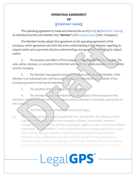Should a Copywriter Use a Contract for Deliverables?
You’ve just poured weeks into crafting perfect website copy for a client. You hit send, expecting praise and payment. Instead, the client demands...
6 min read
LegalGPS : May. 21, 2025
Picture this: You’re a freelance designer who just delivered a stunning logo for a client. They love it—until they demand five more rounds of revisions without extra pay. Or worse, they ghost you when it’s time to settle the invoice. Sound familiar? These nightmares are all too common for freelance designers, but they’re avoidable with one simple tool: a creative services agreement. This legally binding contract can protect your time, income, and creative work, ensuring you’re paid fairly and your rights are secure.


Legal GPS Pro
Protect your business with our complete legal subscription service, designed by top startup attorneys.
But do freelance designers really need a creative services agreement for every project? In short, yes—especially if you want to avoid scope creep, non-payment, or disputes over who owns your designs. In this guide, we’ll explore what a creative services agreement is, why it’s essential for freelance designers, the key clauses to include, when to use one, and how to create your own. With real-world examples and actionable pro tips, you’ll learn how to safeguard your freelance design business and build trust with clients. Let’s dive in.

Creative Services Agreement
Need a Creative Services Agreement template? Download our legally sound agreement for designers writers photographers and more.
Trusted by 1,000+ businesses to safeguard their LLCs.
A creative services agreement is a contract between a freelance designer and a client that outlines the terms of a project. It covers critical details like the scope of work, payment terms, revision limits, intellectual property rights, and what happens if either party wants to end the agreement. Think of it as a roadmap that keeps both you and your client on the same page, preventing misunderstandings that can derail a project.
Why does this matter for freelance designers? Without a contract, you’re vulnerable to common pitfalls like clients demanding extra work for free, refusing to pay on time, or claiming ownership of your designs. A creative services agreement for freelance designers sets clear expectations, protects your income, and shows clients you’re a professional who takes their business seriously. It’s not just about avoiding disputes—it’s about building a sustainable freelance career.
Meet Sarah, a freelance graphic designer hired to create a logo for a startup. The client agreed to a $500 fee for three concepts and two rounds of revisions. But after delivering the designs, the client requested seven more rounds of tweaks, citing “minor changes.” Without a contract, Sarah had no leverage to limit revisions or charge extra. She spent weeks on unpaid work, losing time for other projects. If Sarah had used a creative services agreement, she could have capped revisions at two rounds and charged $100 per additional round, saving her time and income.
Don’t reinvent the wheel. Use a customizable creative services agreement template to save time and ensure your contract is legally sound. These attorney-drafted templates are tailored for freelance designers and cover all the essentials, so you can focus on designing, not drafting legal documents.
A strong creative services agreement for freelance designers isn’t just a formality—it’s your shield against common freelance headaches. Here are the must-have clauses to include:
These clauses address the biggest pain points for freelance designers, from scope creep to IP disputes, ensuring you’re covered no matter what.
Jake, a freelance web designer, built a sleek website for a local restaurant. After launch, the client reused Jake’s custom graphics on merchandise without permission, claiming they “owned” the site. Jake hadn’t used a contract, so he had no legal recourse to stop the misuse or demand compensation. A creative services agreement with a clear IP clause would have specified that Jake retained ownership of the designs and licensed them for website use only, protecting his work and opening the door to additional licensing fees.
Avoid endless tweaks by specifying a set number of revisions in your contract—typically 2–3 rounds for most projects. Include a clause that charges extra for additional revisions (e.g., $50 per round). This keeps clients focused and ensures you’re compensated for extra work.
You might be tempted to skip a contract for small projects or clients you trust, but that’s a risky move. A creative services agreement is essential in these scenarios:


Legal GPS Pro
Protect your business with our complete legal subscription service, designed by top startup attorneys.
Some designers believe myths like “Contracts are only for big projects” or “Verbal agreements are enough.” In reality, even a $200 project can lead to disputes, and verbal agreements are hard to enforce. A contract also builds trust by showing clients you’re organized and professional, making them more likely to hire you.
Lisa, a freelance illustrator, created a branding package for a startup. The client promised to pay $1,500 upon completion but delayed payment for three months, citing cash flow issues. Without a contract, Lisa had no leverage to demand payment or charge late fees. A creative services agreement with payment terms (e.g., 50% upfront, 50% on delivery, with 2% monthly late fees) would have ensured Lisa got paid on time and had legal backing to pursue the debt.
Structure payments in stages—such as a 30% deposit, 30% mid-project, and 40% on completion—to maintain cash flow and reduce the risk of non-payment. Include these milestones in your contract to keep clients accountable.
Creating a freelance designer contract doesn’t have to be daunting. Follow these steps to get started:
When presenting the contract, frame it as a standard part of your process to avoid pushback. For example, say, “This agreement ensures we’re aligned on the project scope and timeline, so we can focus on creating great designs.”
Emma, a freelance UI/UX designer, started using a creative services agreement for all projects. For a recent app design job, she sent a clear contract outlining the scope (three wireframes, two revisions), payment terms (50% upfront), and IP rights (license for app use only). The client appreciated her professionalism, signed promptly, and later hired her for a follow-up project. The contract set a strong foundation for a long-term relationship.
Streamline your process with e-signature tools like DocuSign or HelloSign. These platforms let clients sign contracts digitally, save you time, and keep your records organized for tax season or disputes.
Even the best-intentioned designers can make mistakes with contracts. Here are common pitfalls and how to avoid them:
Tom, a freelance motion designer, used a contract but described the scope as “animation for marketing campaign.” The client assumed this included social media edits and demanded extra work without pay. A detailed scope clause (e.g., “One 30-second animation, two revisions”) would have prevented the misunderstanding and ensured Tom was paid for additional deliverables.
Update your creative services agreement template annually or per project to reflect new services, rates, or legal requirements. This keeps your contracts relevant and protects your growing business.
A creative services agreement isn’t just a piece of paper—it’s a lifeline for freelance designers. By clearly defining the scope, payment terms, revision limits, and IP rights, it protects you from scope creep, non-payment, and disputes, letting you focus on what you do best: designing. Whether you’re working on a $200 logo or a $5,000 branding package, a contract sets the stage for smooth projects and happy clients.
The biggest question now is, "Do you need a lawyer for your business?” For most businesses and in most cases, you don't need a lawyer to start your business. Instead, many business owners rely on Legal GPS Pro to help with legal issues.
Legal GPS Pro is your All-In-One Legal Toolkit for Businesses. Developed by top startup attorneys, Pro gives you access to 100+ expertly crafted templates including operating agreements, NDAs, and service agreements, and an interactive platform. All designed to protect your company and set it up for lasting success.

Legal GPS Pro
Protect your business with our complete legal subscription service, designed by top startup attorneys.
|
Premium Template
Single-use Template |
Legal GPS Pro
Unlimited Access, Best Value |
|
|
| Choose Template | Learn More |
| Trusted by 1000+ businesses | |
Table of Contents

You’ve just poured weeks into crafting perfect website copy for a client. You hit send, expecting praise and payment. Instead, the client demands...

Imagine this: You’re a social media manager who just launched a killer Instagram campaign for a client. The posts are racking up likes, but when you...

You’ve just delivered a 15,000-word translation of a legal contract, expecting prompt payment for weeks of meticulous work. Instead, the client...